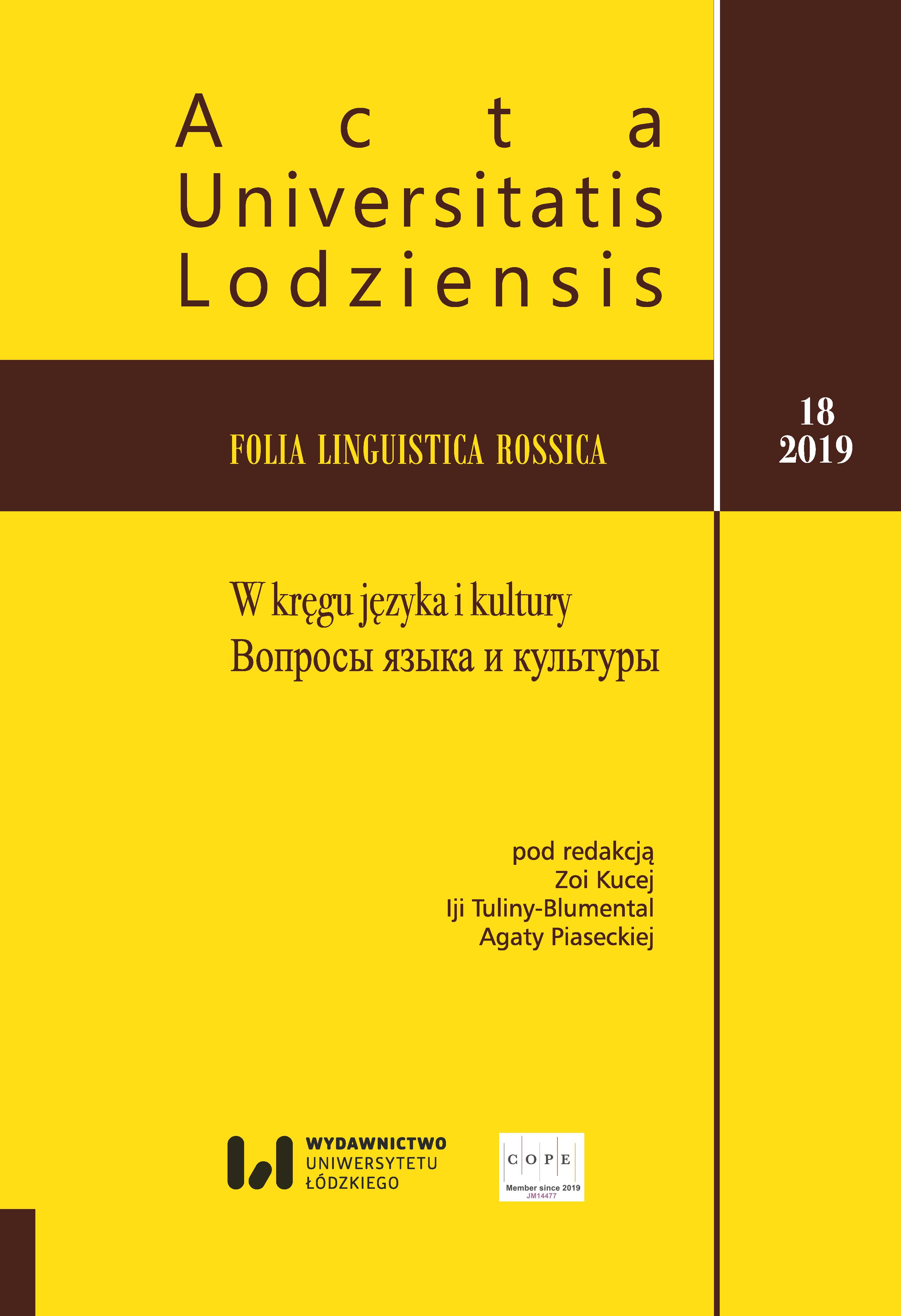О мотивационной соотносительности лексико-семантических дериватов (на примере одного славянского корня). *Chol- и его производные
DOI:
https://doi.org/10.18778/1731-8025.18.03Słowa kluczowe:
семантика корня, этимология, диалекты, языковое сознание, парадигматико-концептуальный потенциал, развитие значенийAbstrakt
С привлечением этимологического, исторического, диалектного, а также современного общеупотребительного литературного материала рассматривается семантика, в первую очередь, русскоязычного корня хол(о)-, отчасти в сопоставлении с рядом славянских языков в контексте особенностей и отличия. Последовательно выводится общее и типичное в значениях таких слов, как холостой, холоп, холуй и др. На базе этого общего прослеживаются далее возможные ответвления в развитии исходных значений. Обращается внимание на специфику не выделяемых уже в настоящее время суффиксов -ст-, -п-, -уй и подобные, с представлением их воздействия на семантику корня при формировании лексем. Анализ подводит к возможности выделения парадигматико-концептуальной схемы и потенциала, лежащих в основе моделирующего развития определяемого круга слов с опорой на их корневую семантику. В завершение выводится и представляется в наглядном типологическом виде, с опорой на составляющие семантические признаки, указанная концептуальная схема-модель для семантики холостой в отношении русскоязычного ареала, с учетом общеупотребительных и диалектных употреблений.
Bibliografia
Бадеева, Е.Я. (2004). Метонимия имени в общественно-политической лексике английского языка: когнитивный и прагматический аспекты. Автореферат. Диссертация кандидата филологических наук, доступ: 10.02.2004. Владивосток.
Google Scholar
Гак, В.Г. (1972). К проблеме общих семантических законов. В: Общее и романское языкознание (151–152). Москва: Издательство Московского университета.
Google Scholar
Даль, В.И. (2000). Толковый словарь живого великорусского языка. Т. 4. Москва: Русский язык.
Google Scholar
Рахилина, Е.В., Карпова, О.С., Резникова, Т.И. (2010). Семантические переходы в атрибутивных конструкциях: метафора, метонимия и ребрендинг (396–455). В: Лингвистика конструкций, Е.В. Рахилина (отв. ред.). Москва: Азбуковник.
Google Scholar
Словарь русских народных говоров. Вып. 41 (2007), Ф.П. Сороколетов (гл. ред.), О.Д. Кузнецова (ред.), Н.И. Андреева-Васина, Е.В. Колосько, О.Н. Крылова (сост.). Санкт-Петербург: Наука.
Google Scholar
Словарь русских народных говоров. Вып. 51 (2019), С.А. Мызников (гл. ред.), О.Д. Кузнецова, Р.В. Гайдамашко (ред.), Ю.Ф. Денисенко (сост). Санкт-Петербург: Наука.
Google Scholar
Срезневский, И.И. (1958). Материалы для словаря древнерусского языка (по изд. 1903–1912 гг.). Т. III. Москва: Государственное издательство иностранных и национальных словарей.
Google Scholar
Черных, П.Я. (1999). Историко-этимологический словарь современного русского языка. 3-е изд., стереотипное. Т. I–II. Москва: Русский язык.
Google Scholar
Этимологический словарь славянских языков. Праславянский лексический фонд. (1981). Вып. 8 (*ха–*jьvьlga), О.Н. Трубачев (ред). Москва: Наука.
Google Scholar
Badeeva, E.Ya. (2004). Metonimiya imeni v obshchestvenno-politicheskoi leksike angliiskogo yazyka: kognitivnyi i pragmaticheskii aspekty. Avtoreferat. Dissertatsiya kandidata filologicheskikh nauk, dostup: 10.02.2004. Vladivostok.
Google Scholar
Chernykh, P.Ya. (1999). Istoriko-etimologicheskii slovar’ sovremennogo russkogo yazyka. 3-e izd., stereotipnoe. T. I–II. Moscow: Russkii yazyk.
Google Scholar
Croft, W. (2003). The role of domains in the interpretation of metaphors and metonymies, Cognitive Linguistics, no. 4, 335–370.
Google Scholar
DOI: https://doi.org/10.1515/cogl.1993.4.4.335
Dal, V.I. (2000). Tolkovyi slovar’ zhivogo velikorusskogo yazyka. T. 4. Moscow: Russkii yazyk.
Google Scholar
Dirven, R. (2002). Metonymy and metaphor: Different mental strategies of conceptualisation. In: Metaphor and Metonymy in comparison and contrast (75–111), R. Dirven and R. Porings (eds.). Berlin–New York: Mouton de Gruyter.
Google Scholar
DOI: https://doi.org/10.1515/9783110219197.1.75
Dirven, R., Verspoor, M. (1998). Cognitive exsploration of language and linguistics. Amsterdam; Philadelphia.
Google Scholar
DOI: https://doi.org/10.1075/clip.1(1999)
Etimologicheskii slovar’ slavyanskikh yazykov. Praslavyanskii leksicheskii fond. (1981). Vyp. 8 (*kha–* jьvьlga), O.N. Trubachev (red). Moscow: Nauka.
Google Scholar
Gak, V.G. (1972). K probleme obshchikh semanticheskikh zakonov. V: Obshchee i romanskoe yazykoznanie (151–152). Moscow: Izdatel’stvo Moskovskogo universiteta.
Google Scholar
Kövecses, Z., Radden, G. (1998). Metonymy. Developing a Cognitive Linguistic View, Cognitive linguistics, vol. 9, no. 1, 37–77.
Google Scholar
DOI: https://doi.org/10.1515/cogl.1998.9.1.37
Lakoff, G., Johnson, M. (1980). Metaphors We Live By. Chicago L.: The University of Chicago Press, XIII.
Google Scholar
Peirsman, Y., Geeraerts, D. (2006). Metonymy as a Prototypical category, Cognitive Linguistics, no. 17(3), 269–316.
Google Scholar
DOI: https://doi.org/10.1515/COG.2006.007
Rakhilina, E.V., Karpova, O.S., Reznikova, T.I. (2010). Semanticheskie perekhody v atributivnykh konstruktsiyakh: metafora, metonimiya i rebrending. (396–455). V: Lingvistika konstruktsii, E.V. Rakhilina (otv. red.). Moscow: Azbukovnik.
Google Scholar
Slovar’ russkikh narodnykh govorov. Vyp. 41 (2007), F.P. Sorokoletov (gl. red.), O.D. Kuznetsova (red.), N.I. Andreeva-Vasina, E.V. Kolos’ko, O.N. Krylova (sost.). St. Petersburg: Nauka.
Google Scholar
Slovar’ russkikh narodnykh govorov. Vyp. 51 (2019), S.A. Myznikov (gl. red.), O.D. Kuznetsova, R.V. Gaidamashko (red.), Yu.F. Denisenko (sost). St. Petersburg: Nauka.
Google Scholar
Sreznevskii, I.I. (1958). Materialy dlya slovarya drevnerusskogo yazyka (po izd. 1903–1912 gg.). T. III. Moscow: Gosudarstvennoe izdatel’stvo inostrannykh i natsional’nykh slovarei.
Google Scholar
Ullmann, S. (1963). Semantic Universals. Universals of Language. Ed. by J. Greenberg. M. I. T. Cambridge (Mass.).
Google Scholar
Pobrania
Opublikowane
Jak cytować
Numer
Dział
Licencja

Utwór dostępny jest na licencji Creative Commons Uznanie autorstwa – Użycie niekomercyjne – Bez utworów zależnych 4.0 Międzynarodowe.









